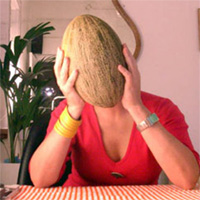Ali&Cia and Food Art
 |
Food, and its flipside cooking, is probably the most universal, non verbal and wise instrument to vehiculate ideas, embedded with messages, symbols, emotions and nostalgias... Perhaps only dance and music can compete with food as a universal cultural instrument to communicate.
-Alicia Ríos, 'Eat Art and Communities: From Oxford to Melbourne' in Moving Wor(l)ds, 6.2, 2006, pp. 177-186.
When you are eating something, you are eating feelings and discoveries and textures; you are eating culture in so many dimensions.
-Alicia Ríos quoted by Stephanie Bunbury, 'Food For Thought' in The Age, 4.3.02.
Everywhere, eating is a culturally transforming- sometimes a magically transforming- act. It has its own alchemy. It transmutes individuals into society and sickness into health. It changes personalities. It can sacralize apparently secular acts. It functions like ritual. It becomes ritual. It can make food divine or diabolic. It can release power. It can create bonds. It can signifiy revenge or love. It can proclaim identity. A change as revolutionary as any in the history of our species happened when eating stopped being merely practical and became ritual, too.
-Felipe Fernández Arnesto, Food: A History, Pan Books, London, 2001, p. 34.
Alicia and Ali&Cia's work deals with many aspects of food, from production through to consumption, and plays with a variety of its multiple meanings and metaphors. Eating is something that all of humankind has in common, something with which everyone is intimately familiar. Along with sex and death it is one of the most universal of all experiences, and it is, of course, far more regular than either. While preparing food and eating serve the physical human need for nourishment, they are also acts that speak of our mood, relationships, cultural identity, beliefs, traditions, aspirations, desires and fears. Food is both a domestic and public affair, both individual and communal. Thus, as a subject and material for making art, food is extremely rich.
In addition to Alicia's performances created for spectators, Ali&Cia creates interactive installations and food events, also highly theatrical, that put the public at the centre of the work. Many regular activities related to food are themselves highly performative and carefully structured, even ritualised. For example, there are many theatrical elements to any dinner party. Guests are welcomed and entertained, perhaps informed of the night's programme or maybe kept wondering until each course is presented and cleared for the next, the whole night staged in a carefully arranged setting. Gay Bilson goes as far as saying that '...all actions which have bearing on food, from preparation to defecation, are performative...'(1) It is no surprise, then, that there are various artists working with food who create performances and actions such as processions, offerings, cooking displays and dinner parties.
Most works involving food are ephemeral, due, of course, to the perishable nature of most food. This aspect is a virtue in itself for many artists, including Alicia, attracted to the magic of a work that has its own life time and then lives on only in memory. She states; '...I like the ephemeral. Nothing remains. I like cooking because it doesn't accumulate.'(2) She doesn't like anything to be left, she likes it all to be consumed or carried away. She describes with enthusiasm the collaboration of Melbourne's local birds in removing the final traces of the edible city, returning the site to its original state. Even at her wedding meal there were no plates or containers and left over food was given to guests to take home or delivered to those that couldn't attend.
Despite the limited duration of the performances, Alicia's works can also be thought of as a process wherein the actual performance forms only one part. She pictures this process as an hourglass; the genesis of the idea and the preparation feeding into the top, the work crystallising in the middle and then after it is broken down and disseminated, transformed into a multitude of memories and mementos carried off by those that attended, who then share their experience with others.
Alicia describes her role as cook/artist as maieutic, that of a midwife, relating it to the Socratic Method whereby knowledge is not presented but elicited from the interlocutor. She thus describes how the public is central to the production of her work. She explains that 'A cook is engaged in a maieutic process. So are performers. After you have been to the theatre, you aren't the same. The actors are maieutic in that they're bringing things out of you. The cook also "delivers" people.'(3) She creates the right conditions to potentiate that which is already latent in the participant, their imagination and secret desires, facilitating their experience and transformation.
She has also described herself as a geisha, thus invoking three traditionally feminine roles not commonly associated with 'high' art- those of cook, midwife and geisha- as analogies for her work as an artist. Her analogies are of those who serve, whose labours are focused on the sensory experience of others. She describes herself as 'anti-diva', not distant and mythologized as some other artists, but engaged with the public and sharing protagonism with them.

(1) Statements by TPS A Progressive Dinner committee members, 1996.
(2) Quoted by Barbara Kirshenblatt-Gimblett, ‘Alicia Rios, tailor of the body’s interior: an interview’ in The Drama Review 41(2) (T154), 1997, pp. 90-110, pp. 109-110.
(3) Ibid., p. 100.
 |